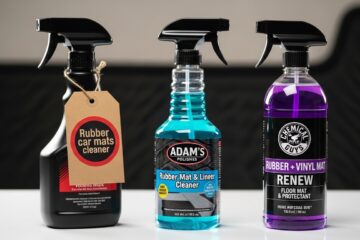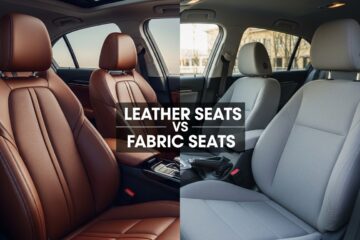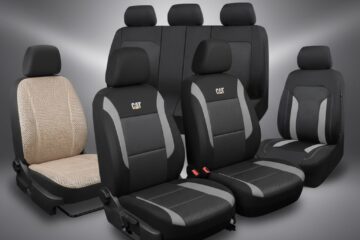You’ve decided on the perfect car model, the engine is just right, and you’ve even picked out the color. But now you’re facing a final, surprisingly difficult decision: the interior. The choice between cloth seats vs leather can feel overwhelming because it impacts your daily comfort, your car’s long-term value, and your wallet.
Many buyers get stuck here. Leather seems luxurious and easy to clean, but is it worth the high price and the scorching heat in summer? Cloth is comfortable and budget-friendly, but will it become a permanent map of coffee spills and dirt?
As an automotive content expert with years of experience reviewing and comparing vehicle features, I’m here to cut through the confusion. This guide provides a clear, honest, and expert-backed comparison based on real-world insights to help you make a well-informed buying decision you won’t regret.
Cloth Seats vs Leather: A Quick Comparison
For those who need a fast answer, this table breaks down the key differences at a glance.
| Factor | Cloth Seats | Leather Seats |
|---|---|---|
| Upfront Cost | Low (Often standard) | High (Often a premium upgrade) |
| Durability | Good; resistant to scuffs but can tear or fray. | Excellent; resistant to tears but can crack or fade if not maintained. |
| Comfort | Excellent; breathable and comfortable in extreme temperatures. | Varies; can be very hot in summer and cold in winter. |
| Maintenance | Moderate; absorbs spills and requires deep cleaning for stains. | Easy; most spills can be wiped away easily. Requires conditioning. |
| Appearance | Functional, comfortable, and available in various patterns. | Premium, luxurious, and sleek. |
| Resale Value | Neutral impact. | Can increase resale value. |

What Are Cloth Seats? An Overview
Cloth seats are the standard upholstery in most base-model vehicles. They are typically made from durable synthetic materials like nylon or polyester, woven together to create a soft, comfortable surface.
Modern cloth interiors have come a long way from the basic fabrics of the past. Today’s options are often engineered for better durability and stain resistance, offering a practical and comfortable experience without the premium price tag.
Key Features of Cloth Seats:
- Affordability: Cloth is almost always the most budget-friendly option.
- Comfort: The fabric is breathable, meaning it doesn’t get excessively hot in the summer or freezing cold in the winter.
- Grip: The textured surface provides more grip, so you don’t slide around during sharp turns.

What Are Leather Seats? An Overview
Leather seats are a hallmark of luxury and are typically offered as an upgrade or as a standard feature in higher-end trims. They are made from treated animal hides, providing a smooth, premium feel and a distinct, pleasant aroma.
There are different grades of leather, from standard-issue to premium Nappa or full-grain options. Many modern cars also use high-quality synthetic alternatives (sometimes called “leatherette” or “vegan leather”) that mimic the look and feel of genuine leather while offering enhanced durability.
Key Features of Leather Seats:
- Premium Aesthetics: Leather immediately elevates the look and feel of a car’s interior.
- Easy Cleaning: Spills and dust can be wiped off the surface with a damp cloth, making it a great choice for parents.
- Hypoallergenic: Unlike cloth, leather doesn’t trap dust mites, pet dander, or other allergens.
Cloth Seats vs Leather: A Side-by-Side Comparison
Let’s dive deeper into how these two popular options stack up against each other in the areas that matter most.
Cost and Value
Cloth seats are the clear winner for budget-conscious buyers. They are usually standard on base and mid-tier models, helping keep the vehicle’s overall price down.
Leather seats are a premium upgrade that can add anywhere from $1,500 to over $5,000 to the car’s sticker price, depending on the brand and quality. However, vehicles with leather interiors often have a higher resale value, which can help you recoup some of that initial investment when you sell the car.
Durability and Longevity
This is a closer race than most people think. High-quality cloth is surprisingly resilient. It resists scuffs and scratches better than leather but is more susceptible to staining and can eventually fray or tear with heavy use.
Leather is exceptionally durable and resistant to punctures. However, it requires regular maintenance. Without proper cleaning and conditioning, leather can dry out, crack, and fade over time, especially when exposed to direct sunlight.
Comfort and Breathability
For pure, year-round comfort, cloth often takes the lead. Its breathable nature allows air to circulate, so it stays relatively cool in the summer and doesn’t feel like a block of ice in the winter.
Leather, on the other hand, is notorious for its temperature extremes. Black leather seats can become dangerously hot on a sunny day, while in winter, they can feel frigid. Many modern luxury cars combat this with heated and ventilated seat functions, but those are costly add-ons.
Maintenance and Ease of Cleaning
Leather has a significant advantage here. Most liquid spills will bead up on the surface, giving you time to wipe them away before they cause a stain. A simple wipe-down is often all that’s needed to keep them looking clean.
Cloth seats are like a sponge. They absorb spills almost instantly, leading to stains that can be difficult and expensive to remove. They also trap dust, crumbs, and pet hair, requiring regular vacuuming and occasional deep cleaning with an upholstery shampooer.
Appearance and Aesthetics
Appearance is subjective, but leather is universally associated with luxury. It provides a sleek, high-end look and that classic “new car smell” that many people love.
Cloth interiors offer a more functional, cozy, and understated feel. While they may not look as “premium,” automakers are now offering more stylish patterns and two-tone designs that can still look very sharp and modern.
Pros & Cons: Cloth vs. Leather at a Glance
| Cloth Seats | Leather Seats |
|---|---|
| ✅ Pros | ✅ Pros |
| More affordable upfront. | Premium and luxurious appearance. |
| More comfortable in hot and cold weather. | Very easy to clean and wipe down spills. |
| Less slippery; better grip while driving. | Increases the vehicle’s resale value. |
| Durable against everyday scuffs and wear. | Hypoallergenic; doesn’t trap dust or dander. |
| ❌ Cons | ❌ Cons |
| Absorbs spills and stains easily. | Significantly more expensive. |
| Can trap dust, allergens, and odors. | Gets extremely hot in summer and cold in winter. |
| Can look less premium or “basic.” | Requires regular conditioning to prevent cracking. |
| May fray or wear thin over many years. | Can be slippery to sit on. |
My Personal Experience: Living with Both
As an automotive expert, I’ve had the chance to live with both cloth and leather seats for extended periods. My experience highlights the real-world trade-offs perfectly.
In a previous family car with premium cloth seats, the comfort was undeniable. On freezing winter mornings, the seats were never painfully cold, and the breathable fabric was a relief during humid summers. However, a single spilled cup of my daughter’s juice turned into a frantic roadside blotting session and ultimately required a professional detailer to fully remove the stain.
My current vehicle has black leather seats. The easy cleanup is a lifesaver—I’ve wiped away everything from melted chocolate to muddy paw prints in seconds. But I’ll never forget the first 100°F day. The burning sensation of sitting on those seats taught me to always use a sunshade. I also invest in a quality leather conditioner every six months, a small chore my cloth seats never required.
Buying Guide: Which One Should You Buy?
The right choice depends entirely on your lifestyle, budget, and priorities.
- For the Budget-Conscious Buyer:
Go with cloth. The savings are significant, and that money can be better spent on other features like advanced safety tech or a better engine. - For Families with Young Children or Pets:
Consider leather. The ability to instantly wipe away spills, crumbs, and pet hair is a game-changer. It will save you countless hours of cleaning and stress. - For the Luxury Seeker:
Choose leather. Nothing matches the premium look, feel, and smell of a genuine leather interior. It’s a key part of the luxury car experience. - For Drivers in Extreme Climates (Very Hot or Very Cold):
Lean towards cloth. Unless you are also getting heated and ventilated seats (a costly package), cloth provides far more consistent, year-round comfort without the temperature shocks. - For the Long-Term Owner (5+ Years):
It’s a tie, with a slight edge to well-maintained leather. Properly cared-for leather can outlast cloth. However, high-quality modern cloth is very durable, and replacing a single damaged cloth panel is often cheaper than repairing cracked leather.
For Families with Young Children or Pets
Making the right choices for family-friendly gear doesn’t stop with your car’s upholstery. If you’re preparing for a new arrival, choosing the right infant seat is just as critical. You can see how we apply the same detailed comparison process in our guide to the Chicco KeyFit 30 vs Chicco KeyFit 35.
Final Verdict
The cloth seats vs leather debate doesn’t have a single winner—it has a “right choice for you.” It’s a classic trade-off between practical comfort and premium luxury.
If your top priorities are affordability and year-round comfort right out of the box, cloth seats are an excellent and practical choice.
If you value a high-end aesthetic, easy cleaning, and a potential boost in resale value—and are willing to pay the premium and handle the maintenance—then leather seats are the way to go.
Before you decide, make sure to sit in both types at the dealership. Feel the texture, consider your climate, and be honest about how much time you’re willing to spend on maintenance. Your daily drive will thank you for it.
Frequently Asked Questions (FAQ)
Are leather seats really worth the extra cost?
It depends on your priorities. If you value a premium look, easy cleanup (great for kids/pets), and higher resale value, then yes, they can be worth it. If you are more focused on upfront cost and comfort in extreme temperatures, cloth is a more practical choice.
Which is more durable in the long run, cloth or leather seats?
Properly maintained leather is generally more durable and can last the lifetime of the vehicle without tearing. However, it is susceptible to cracking and fading if neglected. High-quality cloth is very durable against scuffs but can stain, fray, or tear over time with heavy, pointed pressure.
Do cloth seats get smelly?
Cloth seats can absorb moisture, spills, sweat, and smoke, which can lead to lingering odors if not cleaned properly. Leather is non-porous and resists odors much more effectively, making it a better option for smokers or those concerned about smells.
How do you protect cloth seats from stains?
The best way to protect cloth seats is to treat them with a fabric-protecting spray like Scotchgard right after you buy the car. This creates a barrier that helps repel liquids. Additionally, using seat covers is a highly effective way to prevent stains and wear.
Are heated and ventilated seats available with cloth?
Heated seats are commonly available with cloth interiors, especially in colder climates. However, ventilated or “cooled” seats are almost exclusively paired with perforated leather, as the material is better suited for airflow. This is a key consideration for buyers in very hot regions.




